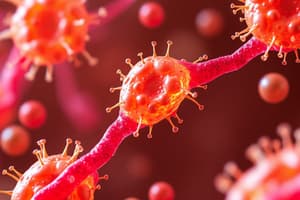Podcast
Questions and Answers
What is the primary function of lysosomes in a cell?
What is the primary function of lysosomes in a cell?
- Detoxifying harmful substances
- Breaking down waste and cellular debris (correct)
- Photosynthesis
- Storing water and nutrients
What is the main outcome of mitosis?
What is the main outcome of mitosis?
- Four genetically identical daughter cells
- Two genetically identical daughter cells (correct)
- Two genetically diverse daughter cells
- Four genetically diverse somatic cells
Which organelle is specifically involved in photosynthesis?
Which organelle is specifically involved in photosynthesis?
- Lysosomes
- Chloroplasts (correct)
- Vacuoles
- Mitochondria
What is a distinctive feature of meiosis compared to mitosis?
What is a distinctive feature of meiosis compared to mitosis?
How do cells communicate with each other?
How do cells communicate with each other?
What type of cells lack a nucleus and membrane-bound organelles?
What type of cells lack a nucleus and membrane-bound organelles?
What is the primary component of the cell membrane?
What is the primary component of the cell membrane?
Which organelle is primarily responsible for energy production in the cell?
Which organelle is primarily responsible for energy production in the cell?
What role do membrane proteins NOT play in the cell membrane?
What role do membrane proteins NOT play in the cell membrane?
The jelly-like substance that fills the cell is known as what?
The jelly-like substance that fills the cell is known as what?
What structure within the nucleus is primarily involved in ribosome production?
What structure within the nucleus is primarily involved in ribosome production?
Which transport mechanism requires energy to move substances across the cell membrane?
Which transport mechanism requires energy to move substances across the cell membrane?
What is the role of the Golgi apparatus in the cell?
What is the role of the Golgi apparatus in the cell?
Flashcards
Lysosome function
Lysosome function
Lysosomes contain enzymes that break down waste and cellular debris.
Vacuole function
Vacuole function
Vacuoles store water, nutrients, and waste, mainly in plant cells.
Mitosis outcome
Mitosis outcome
Mitosis produces two identical daughter cells from one parent cell.
Meiosis outcome
Meiosis outcome
Signup and view all the flashcards
Cell communication basics
Cell communication basics
Signup and view all the flashcards
Cell Structure
Cell Structure
Signup and view all the flashcards
Cell Membrane
Cell Membrane
Signup and view all the flashcards
Cytoplasm
Cytoplasm
Signup and view all the flashcards
Nucleus
Nucleus
Signup and view all the flashcards
Mitochondria
Mitochondria
Signup and view all the flashcards
Prokaryotic Cell
Prokaryotic Cell
Signup and view all the flashcards
Eukaryotic Cell
Eukaryotic Cell
Signup and view all the flashcards
Cellular Respiration
Cellular Respiration
Signup and view all the flashcards
Study Notes
Cell Structure and Function
- Cells are the basic units of life, and all living organisms are composed of one or more cells.
- Cells exhibit a remarkable diversity in their shapes and sizes, reflecting their specialized functions.
- Cell structures perform specific functions essential for maintaining life.
- Prokaryotic cells (bacteria and archaea) are simpler, lacking a nucleus and other membrane-bound organelles.
- Eukaryotic cells (plants, animals, fungi, and protists) are complex, possessing a nucleus and a variety of membrane-bound organelles.
Cell Membrane
- The cell membrane, also known as the plasma membrane, is a selectively permeable barrier that encloses the cell's contents.
- It is primarily composed of a phospholipid bilayer interspersed with proteins and cholesterol.
- The phospholipid bilayer provides a hydrophobic barrier that regulates the passage of substances into and out of the cell.
- Membrane proteins play crucial roles in transport, enzymatic activity, cell signaling, and cell adhesion.
- Different kinds of transport mechanisms across the membrane include passive transport (e.g. diffusion, osmosis) and active transport (requiring energy).
Cytoplasm
- The cytoplasm is the jelly-like substance that fills the cell and surrounds the nucleus.
- It contains various organelles – specialized structures that carry out specific functions within the cell.
- Cytosol, the liquid component of cytoplasm, contains water, dissolved ions, small molecules, and macromolecules.
- Cytoskeleton – a network of protein fibers (microfilaments, intermediate filaments, microtubules) in the cytoplasm which gives shape to the cell, and enables movement.
Nucleus
- The nucleus is the control center of the cell, containing the cell's genetic material (DNA).
- It is enclosed by a double membrane, the nuclear envelope, with pores that regulate the passage of substances between the nucleus and cytoplasm.
- Within the nucleus is the nucleolus, a region involved in ribosome biogenesis.
- The DNA in the nucleus is organized into tightly coiled structures called chromosomes.
Organelles
- Mitochondria are the "powerhouses" of the cell, generating ATP (energy) through cellular respiration.
- Ribosomes are responsible for protein synthesis.
- Endoplasmic reticulum (ER) is a network of membranes involved in protein synthesis, folding, and transport.
- Golgi apparatus modifies, sorts, and packages proteins.
- Lysosomes contain digestive enzymes, breaking down waste and cellular debris.
- Vacuoles, primarily in plant cells, store water, nutrients, and waste products.
- Peroxisomes contain enzymes that detoxify harmful substances.
- Chloroplasts (only in plants) are responsible for photosynthesis converting light energy into chemical energy.
Cell Division
- Cell division is a fundamental process enabling growth, repair, and reproduction in organisms.
- Two main types of cell division are mitosis (for somatic cells) and meiosis (for gametes).
- Mitosis results in two genetically identical daughter cells from a single parent cell.
- Meiosis results in four genetically diverse daughter cells (gametes) from a single parent cell.
Cell Communication
- Cells communicate with each other through various mechanisms, including direct contact, signaling molecules, and receptor proteins.
- These interactions are essential for coordinating cellular activities and maintaining homeostasis.
Studying That Suits You
Use AI to generate personalized quizzes and flashcards to suit your learning preferences.




